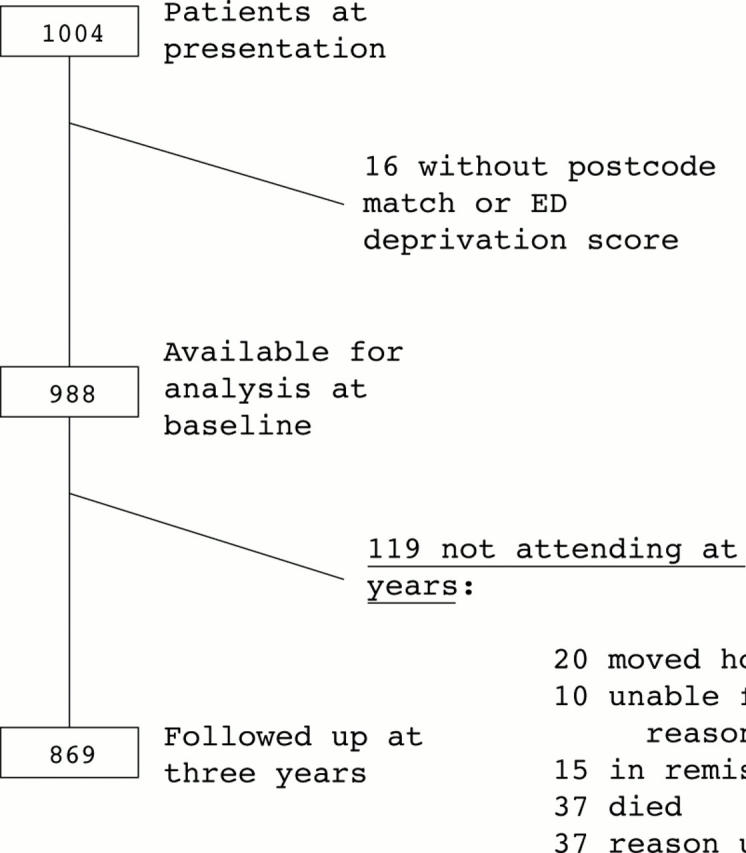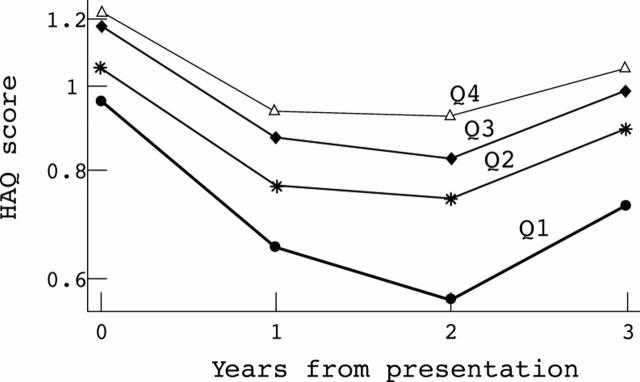Abstract
OBJECTIVE—To assess how socioeconomic deprivation influences the presentation, treatment, and outcome of patients with rheumatoid arthritis (RA). METHODS—Three year follow up of 869 consecutive patients with RA from nine hospital rheumatology clinics, with patients categorised by the Carstairs deprivation score of their enumeration district of residence. Outcomes included Health Assessment Questionnaire (HAQ), joint and pain scores, grip strength, functional grade, radiological evidence of bony erosions, and medical/surgical interventions. RESULTS—Patients from more deprived enumeration districts presented with more severe disease as judged by the HAQ score and joint scores. An increase from the 5th to the 95th centile of the Carstairs distribution was associated with an odds ratio of 1.87 (95% confidence interval (95% CI) 1.31 to 2.66) for an above-median HAQ score and 1.77 (95% CI 1.23 to 2.54) for an above-median joint score. Statistically non-significant deprivation trends were seen with erythrocyte sedimentation rate, pain score, and grip strength. By three years, despite no important differences in clinical management, socioeconomic differentials had worsened or remained unchanged such that clear deprivation trends were then seen in HAQ (p=0.002) and joint scores (p=0.001), in grip strength (p=0.008), and in functional grade (p=0.003). The association between deprivation and HAQ at three years was present after adjustment for age, sex, treatment centre, and HAQ at presentation (adjusted odds ratio 1.74, 95% CI 1.1 to 2.74). CONCLUSIONS—Socioeconomic deprivation was associated with a worse clinical course of rheumatoid disease, and this effect was already apparent at presentation, but not with systematic differentials in its treatment. This suggests that individual susceptibility and lifestyle factors contribute to socioeconomic differentials in outcome, an observation that has implications for clinical management.
Full Text
The Full Text of this article is available as a PDF (135.3 KB).
Figure 1 .

Patient sample. ED = enumeration district.
Figure 2 .
Change in mean Health Assessment Questionnaire (HAQ) score (log scale) by quartile (Q1 least deprived, Q4 most deprived) of the Carstairs deprivation score.
Selected References
These references are in PubMed. This may not be the complete list of references from this article.
- Acheson D. Equality of health: dream or reality? J R Coll Physicians Lond. 1999 Jan-Feb;33(1):70–77. [PMC free article] [PubMed] [Google Scholar]
- Armstrong B. G., Sloan M. Ordinal regression models for epidemiologic data. Am J Epidemiol. 1989 Jan;129(1):191–204. doi: 10.1093/oxfordjournals.aje.a115109. [DOI] [PubMed] [Google Scholar]
- Arnett F. C., Edworthy S. M., Bloch D. A., McShane D. J., Fries J. F., Cooper N. S., Healey L. A., Kaplan S. R., Liang M. H., Luthra H. S. The American Rheumatism Association 1987 revised criteria for the classification of rheumatoid arthritis. Arthritis Rheum. 1988 Mar;31(3):315–324. doi: 10.1002/art.1780310302. [DOI] [PubMed] [Google Scholar]
- Bankhead C., Silman A., Barrett B., Scott D., Symmons D. Incidence of rheumatoid arthritis is not related to indicators of socioeconomic deprivation. J Rheumatol. 1996 Dec;23(12):2039–2042. [PubMed] [Google Scholar]
- Berkanovic E., Oster P., Wong W. K., Bulpitt K., Clements P., Sterz M., Paulus H. The relationship between socioeconomic status and recently diagnosed rheumatoid arthritis. Arthritis Care Res. 1996 Dec;9(6):257–262. [PubMed] [Google Scholar]
- Borg G., Allander E., Lund B., Berg E., Brodin U., Pettersson H., Trang L. Auranofin improves outcome in early rheumatoid arthritis. Results from a 2-year, double blind placebo controlled study. J Rheumatol. 1988 Dec;15(12):1747–1754. [PubMed] [Google Scholar]
- Bosma H., Schrijvers C., Mackenbach J. P. Socioeconomic inequalities in mortality and importance of perceived control: cohort study. BMJ. 1999 Dec 4;319(7223):1469–1470. doi: 10.1136/bmj.319.7223.1469. [DOI] [PMC free article] [PubMed] [Google Scholar]
- Carstairs V. Deprivation indices: their interpretation and use in relation to health. J Epidemiol Community Health. 1995 Dec;49 (Suppl 2):S3–S8. doi: 10.1136/jech.49.suppl_2.s3. [DOI] [PMC free article] [PubMed] [Google Scholar]
- Corbett M., Dalton S., Young A., Silman A., Shipley M. Factors predicting death, survival and functional outcome in a prospective study of early rheumatoid disease over fifteen years. Br J Rheumatol. 1993 Aug;32(8):717–723. doi: 10.1093/rheumatology/32.8.717. [DOI] [PubMed] [Google Scholar]
- Criswell L. A., Katz P. P. Relationship of education level to treatment received for rheumatoid arthritis. J Rheumatol. 1994 Nov;21(11):2026–2033. [PubMed] [Google Scholar]
- Eberhardt K. B., Fex E. Functional impairment and disability in early rheumatoid arthritis--development over 5 years. J Rheumatol. 1995 Jun;22(6):1037–1042. [PubMed] [Google Scholar]
- Fries J. F., Spitz P. W., Young D. Y. The dimensions of health outcomes: the health assessment questionnaire, disability and pain scales. J Rheumatol. 1982 Sep-Oct;9(5):789–793. [PubMed] [Google Scholar]
- Leigh J. P., Fries J. F. Predictors of disability in a longitudinal sample of patients with rheumatoid arthritis. Ann Rheum Dis. 1992 May;51(5):581–587. doi: 10.1136/ard.51.5.581. [DOI] [PMC free article] [PubMed] [Google Scholar]
- Maiden N., Capell H. A., Madhok R., Hampson R., Thomson E. A. Does social disadvantage contribute to the excess mortality in rheumatoid arthritis patients? Ann Rheum Dis. 1999 Sep;58(9):525–529. doi: 10.1136/ard.58.9.525. [DOI] [PMC free article] [PubMed] [Google Scholar]
- Marmot M. G., Bosma H., Hemingway H., Brunner E., Stansfeld S. Contribution of job control and other risk factors to social variations in coronary heart disease incidence. Lancet. 1997 Jul 26;350(9073):235–239. doi: 10.1016/s0140-6736(97)04244-x. [DOI] [PubMed] [Google Scholar]
- Marmot M. G., McDowall M. E. Mortality decline and widening social inequalities. Lancet. 1986 Aug 2;2(8501):274–276. doi: 10.1016/s0140-6736(86)92085-4. [DOI] [PubMed] [Google Scholar]
- McEntegart A., Morrison E., Capell H. A., Duncan M. R., Porter D., Madhok R., Thomson E. A. Effect of social deprivation on disease severity and outcome in patients with rheumatoid arthritis. Ann Rheum Dis. 1997 Jul;56(7):410–413. doi: 10.1136/ard.56.7.410. [DOI] [PMC free article] [PubMed] [Google Scholar]
- Mitchell J. M., Burkhauser R. V., Pincus T. The importance of age, education, and comorbidity in the substantial earnings losses of individuals with symmetric polyarthritis. Arthritis Rheum. 1988 Mar;31(3):348–357. doi: 10.1002/art.1780310306. [DOI] [PubMed] [Google Scholar]
- Pincus T., Callahan L. F., Vaughn W. K. Questionnaire, walking time and button test measures of functional capacity as predictive markers for mortality in rheumatoid arthritis. J Rheumatol. 1987 Apr;14(2):240–251. [PubMed] [Google Scholar]
- Ritchie D. M., Boyle J. A., McInnes J. M., Jasani M. K., Dalakos T. G., Grieveson P., Buchanan W. W. Clinical studies with an articular index for the assessment of joint tenderness in patients with rheumatoid arthritis. Q J Med. 1968 Jul;37(147):393–406. [PubMed] [Google Scholar]
- Talamo J., Frater A., Gallivan S., Young A. Use of the short form 36 (SF36) for health status measurement in rheumatoid arthritis. Br J Rheumatol. 1997 Apr;36(4):463–469. doi: 10.1093/rheumatology/36.4.463. [DOI] [PubMed] [Google Scholar]
- Tugwell P., Boers M. OMERACT conference on outcome measures in rheumatoid arthritis clinical trials: introduction. J Rheumatol. 1993 Mar;20(3):528–530. [PubMed] [Google Scholar]
- Vliet Vlieland T. P., Buitenhuis N. A., van Zeben D., Vandenbroucke J. P., Breedveld F. C., Hazes J. M. Sociodemographic factors and the outcome of rheumatoid arthritis in young women. Ann Rheum Dis. 1994 Dec;53(12):803–806. doi: 10.1136/ard.53.12.803. [DOI] [PMC free article] [PubMed] [Google Scholar]
- Young A., Corbett M., Winfield J., Jaqueremada D., Williams P., Papasavvas G., Hay F., Roitt I. A prognostic index for erosive changes in the hands, feet, and cervical spines in early rheumatoid arthritis. Br J Rheumatol. 1988 Apr;27(2):94–101. doi: 10.1093/rheumatology/27.2.94. [DOI] [PubMed] [Google Scholar]
- Young A. Short-term outcomes in recent-onset rheumatoid arthritis. Br J Rheumatol. 1995 Nov;34 (Suppl 2):79–86. [PubMed] [Google Scholar]
- Young A., van der Heijde D. M. Can we predict aggressive disease? Baillieres Clin Rheumatol. 1997 Feb;11(1):27–48. doi: 10.1016/s0950-3579(97)80031-3. [DOI] [PubMed] [Google Scholar]
- van Leeuwen M. A., van der Heijde D. M., van Rijswijk M. H., Houtman P. M., van Riel P. L., van de Putte L. B., Limburg P. C. Interrelationship of outcome measures and process variables in early rheumatoid arthritis. A comparison of radiologic damage, physical disability, joint counts, and acute phase reactants. J Rheumatol. 1994 Mar;21(3):425–429. [PubMed] [Google Scholar]
- van der Heide A., Jacobs J. W., Bijlsma J. W., Heurkens A. H., van Booma-Frankfort C., van der Veen M. J., Haanen H. C., Hofman D. M., van Albada-Kuipers G. A., ter Borg E. J. The effectiveness of early treatment with "second-line" antirheumatic drugs. A randomized, controlled trial. Ann Intern Med. 1996 Apr 15;124(8):699–707. doi: 10.7326/0003-4819-124-8-199604150-00001. [DOI] [PubMed] [Google Scholar]



